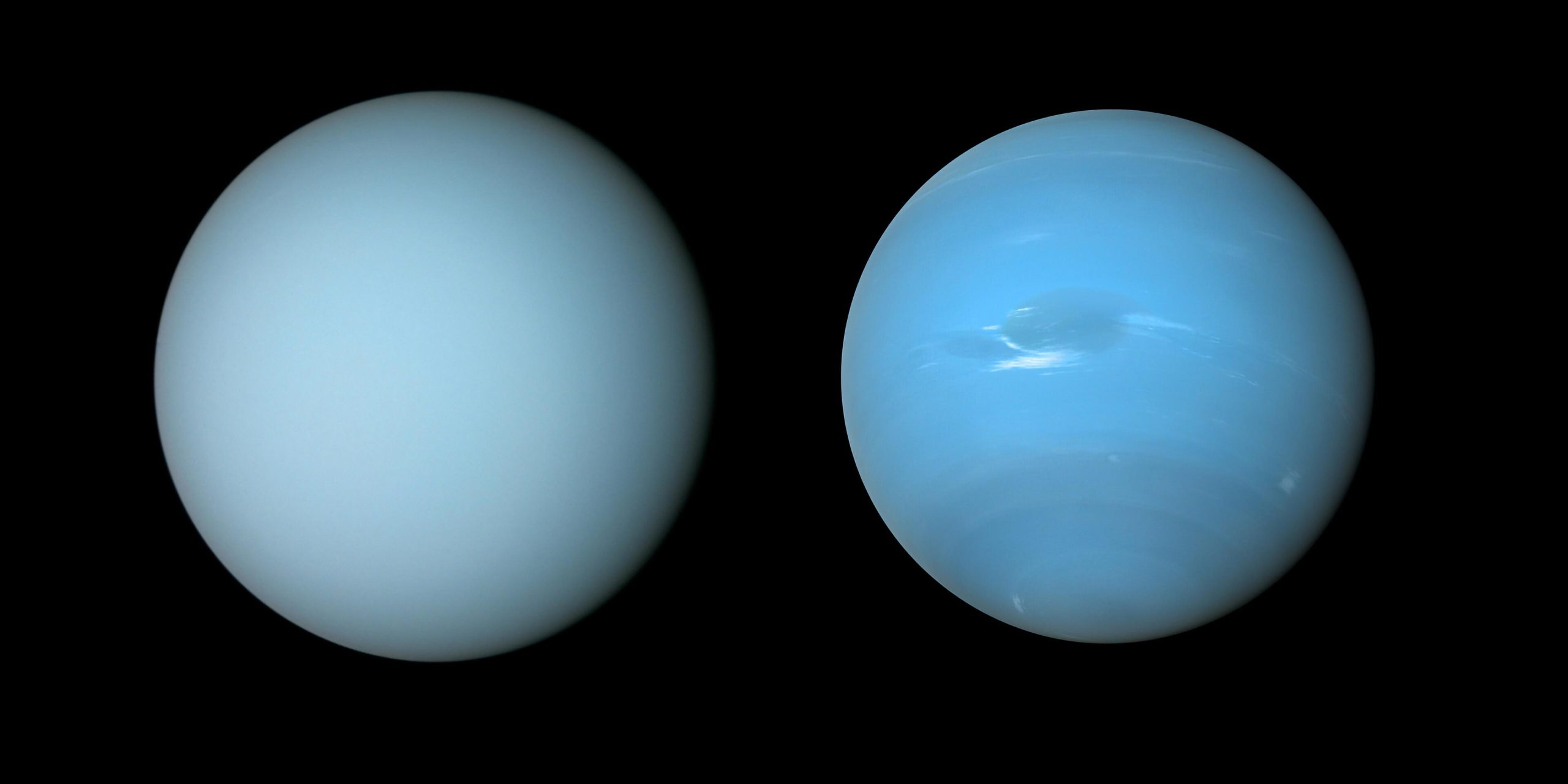Космическият кораб на НАСА Voyager 2 засне тези изгледи на Уран (вляво) и Нептун (вдясно) по време на прелитане на планети през 80-те години на миналия век. Кредит: NASA/JPL-Caltech/B. Johnson
Наблюденията от обсерваторията Gemini и други телескопи разкриват прекомерна мъгла[{“ attribute=““>Uranus makes it paler than Neptune.
Astronomers may now understand why the similar planets Uranus and Neptune have distinctive hues. Researchers constructed a single atmospheric model that matches observations of both planets using observations from the Gemini North telescope, the NASA Infrared Telescope Facility, and the Hubble Space Telescope. The model reveals that excess haze on Uranus accumulates in the planet’s stagnant, sluggish atmosphere, giving it a lighter hue than Neptune.
Планетите Нептун и Уран споделят много общо – имат сходни маси, размери и атмосферен състав – но външният им вид е значително различен. При видими дължини на вълната Нептун е видимо по-син на цвят, докато Уран е с по-блед оттенък на циан. Астрономите вече имат обяснение защо двете планети са толкова различни по цвят.
Ново изследване показва, че слоят от концентрирана мъгла, открит и на двете планети, е по-дебел на Уран от подобен слой на Нептун и „избелва“ външния вид на Уран повече, отколкото на Нептун.[1] Ако няма мъгла вътре атмосфера От Нептун и Уран и двете ще изглеждат приблизително еднакви в синьо.[2]
Това заключение идва от модел[3] че международен екип, ръководен от Патрик Ъруин, професор по планетарна физика в Оксфордския университет, е разработил, за да опише аерозолните слоеве в атмосферите на Нептун и Уран.[4] Предишни изследвания на горните атмосфери на тези планети се фокусираха върху външния вид на атмосферата само при определени дължини на вълната. Въпреки това, този нов модел, който се състои от множество атмосферни слоеве, съвпада с наблюденията от двете планети в широк диапазон от дължини на вълните. Новият модел включва също размити частици в по-дълбоки слоеве, за които преди се смяташе, че съдържат само облаци от метан и лед от сероводород.

Тази диаграма показва три слоя аерозоли в атмосферите на Уран и Нептун, проектирани от екип от учени, ръководен от Патрик Ъруин. Висотомерът на графиката представя налягането над 10 бара.
Най-дълбокият слой (аерозолен слой-1) е дебел и се състои от смес от лед от сероводород и частици от взаимодействието на планетарните атмосфери със слънчевата светлина.
Основният слой, влияещ върху цветовете, е средният слой, който е слой от частици мъгла (наричан в статията аерозолен слой-2), който е по-дебел на Уран, отколкото на Нептун. Екипът подозира, че и на двете планети метановият лед се кондензира върху частиците в този слой, издърпвайки частиците по-дълбоко в атмосферата, докато пада метановия сняг. Тъй като атмосферата на Нептун е по-активна и турбулентна от тази на Уран, екипът вярва, че атмосферата на Нептун е по-ефективна при шунтиране на метанови частици в слоя мъгла и производството на този сняг. Това премахва повече мъгла и поддържа слоя мъгла на Нептун по-тънък, отколкото е на Уран, което означава, че синьото на Нептун изглежда по-силно.
Над двата слоя има разширен слой мъгла (аерозолен слой 3), подобен на слоя отдолу, но по-крехък. На Нептун над този слой също се образуват големи метанови ледени частици.
Автор: Gemini International Observatory/NOIRLab/NSF/AURA, J. da Silva/NASA/JPL-Caltech/B. Johnson
„Това е първият модел, който синхронно отговаря на наблюденията на отразена слънчева светлина от ултравиолетова до близка до инфрачервена“, обясни Ъруин, водещ автор на изследователска статия, представяща това откритие в Journal of Geophysical Research: Planets. „Той е и първият, който обяснява разликата във видимия цвят между Уран и Нептун.“
Моделът на екипа се състои от три слоя аерозоли на различни височини.[5] Основният слой, влияещ върху цветовете, е средният слой, който е слой от частици мъгла (наричан в хартията като аерозолен слой-2), който е по-дебел над Уран От Нептун. Екипът подозира, че и на двете планети метановият лед се кондензира върху частиците в този слой, издърпвайки частиците по-дълбоко в атмосферата, докато пада метановия сняг. Тъй като атмосферата на Нептун е по-активна и турбулентна от тази на Уран, екипът вярва, че атмосферата на Нептун е по-ефективна при шунтиране на метанови частици в слоя мъгла и производството на този сняг. Това премахва повече мъгла и поддържа слоя мъгла на Нептун по-тънък, отколкото е на Уран, което означава, че синьото на Нептун изглежда по-силно.
Майк Вонг, астроном в[{“ attribute=““>University of California, Berkeley, and a member of the team behind this result. “Explaining the difference in color between Uranus and Neptune was an unexpected bonus!”
To create this model, Irwin’s team analyzed a set of observations of the planets encompassing ultraviolet, visible, and near-infrared wavelengths (from 0.3 to 2.5 micrometers) taken with the Near-Infrared Integral Field Spectrometer (NIFS) on the Gemini North telescope near the summit of Maunakea in Hawai‘i — which is part of the international Gemini Observatory, a Program of NSF’s NOIRLab — as well as archival data from the NASA Infrared Telescope Facility, also located in Hawai‘i, and the NASA/ESA Hubble Space Telescope.
The NIFS instrument on Gemini North was particularly important to this result as it is able to provide spectra — measurements of how bright an object is at different wavelengths — for every point in its field of view. This provided the team with detailed measurements of how reflective both planets’ atmospheres are across both the full disk of the planet and across a range of near-infrared wavelengths.
“The Gemini observatories continue to deliver new insights into the nature of our planetary neighbors,” said Martin Still, Gemini Program Officer at the National Science Foundation. “In this experiment, Gemini North provided a component within a suite of ground- and space-based facilities critical to the detection and characterization of atmospheric hazes.”
The model also helps explain the dark spots that are occasionally visible on Neptune and less commonly detected on Uranus. While astronomers were already aware of the presence of dark spots in the atmospheres of both planets, they didn’t know which aerosol layer was causing these dark spots or why the aerosols at those layers were less reflective. The team’s research sheds light on these questions by showing that a darkening of the deepest layer of their model would produce dark spots similar to those seen on Neptune and perhaps Uranus.
Notes
- This whitening effect is similar to how clouds in exoplanet atmospheres dull or ‘flatten’ features in the spectra of exoplanets.
- The red colors of the sunlight scattered from the haze and air molecules are more absorbed by methane molecules in the atmosphere of the planets. This process — referred to as Rayleigh scattering — is what makes skies blue here on Earth (though in Earth’s atmosphere sunlight is mostly scattered by nitrogen molecules rather than hydrogen molecules). Rayleigh scattering occurs predominantly at shorter, bluer wavelengths.
- An aerosol is a suspension of fine droplets or particles in a gas. Common examples on Earth include mist, soot, smoke, and fog. On Neptune and Uranus, particles produced by sunlight interacting with elements in the atmosphere (photochemical reactions) are responsible for aerosol hazes in these planets’ atmospheres.
- A scientific model is a computational tool used by scientists to test predictions about a phenomena that would be impossible to do in the real world.
- The deepest layer (referred to in the paper as the Aerosol-1 layer) is thick and is composed of a mixture of hydrogen sulfide ice and particles produced by the interaction of the planets’ atmospheres with sunlight. The top layer is an extended layer of haze (the Aerosol-3 layer) similar to the middle layer but more tenuous. On Neptune, large methane ice particles also form above this layer.
More information
This research was presented in the paper “Hazy blue worlds: A holistic aerosol model for Uranus and Neptune, including Dark Spots” to appear in the Journal of Geophysical Research: Planets.
The team is composed of P.G.J. Irwin (Department of Physics, University of Oxford, UK), N.A. Teanby (School of Earth Sciences, University of Bristol, UK), L.N. Fletcher (School of Physics & Astronomy, University of Leicester, UK), D. Toledo (Instituto Nacional de Tecnica Aeroespacial, Spain), G.S. Orton (Jet Propulsion Laboratory, California Institute of Technology, USA), M.H. Wong (Center for Integrative Planetary Science, University of California, Berkeley, USA), M.T. Roman (School of Physics & Astronomy, University of Leicester, UK), S. Perez-Hoyos (University of the Basque Country, Spain), A. James (Department of Physics, University of Oxford, UK), J. Dobinson (Department of Physics, University of Oxford, UK).
NSF’s NOIRLab (National Optical-Infrared Astronomy Research Laboratory), the US center for ground-based optical-infrared astronomy, operates the international Gemini Observatory (a facility of NSF, NRC–Canada, ANID–Chile, MCTIC–Brazil, MINCyT–Argentina, and KASI–Republic of Korea), Kitt Peak National Observatory (KPNO), Cerro Tololo Inter-American Observatory (CTIO), the Community Science and Data Center (CSDC), and Vera C. Rubin Observatory (operated in cooperation with the Department of Energy’s SLAC National Accelerator Laboratory). It is managed by the Association of Universities for Research in Astronomy (AURA) under a cooperative agreement with NSF and is headquartered in Tucson, Arizona. The astronomical community is honored to have the opportunity to conduct astronomical research on Iolkam Du’ag (Kitt Peak) in Arizona, on Maunakea in Hawai‘i, and on Cerro Tololo and Cerro Pachón in Chile. We recognize and acknowledge the very significant cultural role and reverence that these sites have for the Tohono O’odham Nation, the Native Hawaiian community, and the local communities in Chile, respectively.

„Тотален фен на Twitter. Нежно очарователен почитател на бекона. Сертифициран специалист по интернет.“






More Stories
Разкриване на тайните на структурата на мозъка при пациенти с аутизъм
Ветеринарите бият тревога за потенциално смъртоносна болест, засягаща кучетата
Космическият сблъсък, който направи сърцето на Плутон